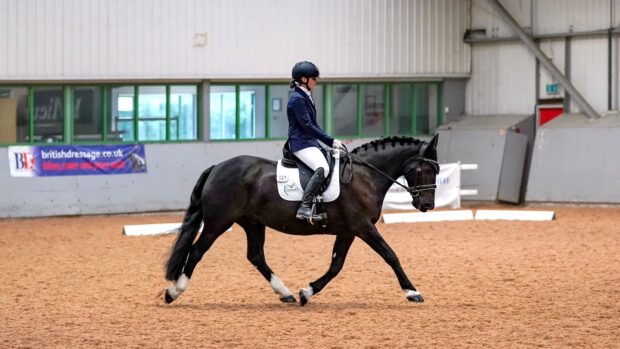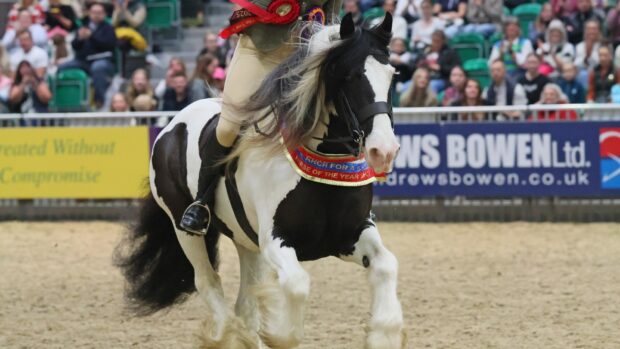Cobs are one of the most popular riding horses in the UK. They are hardy, versatile, able to turn their hoof to most things from low level dressage and eventing, to winning at the Horse of the Year Show, or to driving and hacking along roads and trails.
The cob is not really a breed; technically, it’s a type, described by the British Show Horse Association as: “A short-legged animal, with bone, substance and quality, capable of carrying a substantial weight. The cob should be well-mannered and ideal for nervous or elderly riders. Cobs should have sensible heads, (sometimes Roman nosed), a full, generous eye, shapely neck, well muscled… and with a well-defined wither.”
While they have a reputation for being steady and sensible (and many are), some cobs can be quite sharp and forward, as a type only describes the animal’s physical appearance, not its temperament.
There are several varieties of cob. The “traditional cob” or “Gypsy cob” is characterised by thick feathering on its legs and a full mane and tail, and they are frequently (but not always) coloured. They were originally bred by the Romany or traveller people of Britain and Ireland to be strong enough to pull their caravans, while being gentle enough to be handled by children. Before the Second World War, the Romany adopted any cast-off equine, especially tobiano animals, coloured horses having gone out of fashion among the landed classes, so they were cheap.
Edward Hart, an agricultural journalist and historian of heavy horses, speculates that the patterns common to the Gypsy horse may have come from coloured Shires. The Romany horse breeders started a more deliberate breeding programme in the 1950s by crossing Dales and Fell mares with Clydesdale stallions. To improve their action, Welsh section D and Hackney bloodlines were introduced.
The Romany community passed on information verbally, so little is known about the founding sires, except that one was called The Old Coal Horse, who apparently pulled a coal wagon in Dublin, and the another was called Sonny Mays Horse. No official registries appeared until 1996, when an American couple, Dennis and Cindy Thomson, “discovered” the animals on a trip to England. To their surprise, the ‘breed’ didn’t even have a name, so they called it the Gypsy Vanner and founded the Gypsy Vanner Horse Society. The name caught on in North America, where the horses sell for many thousands of dollars, but not in the UK or Ireland.
Irish breeders didn’t establish a written studbook until the Irish Cob Studbook was founded 1998, and a UK-based registry, the Traditional Gypsy Cob Association, was launched in 2005.
The traditional cob, with its striking looks and reputation for being steady, sound and forgiving, has gained popularity as the ideal amateur ride in almost every discipline. They might not be favourites to win an international grand prix class, but they are Jacks of all trades.
Flore North, who breeds cobs at her Cairnview Stud in Co. Meath, told Horse & Hound: “What drew us to this breed (Irish cobs), is their temperament. They are extremely kind and usually really enjoy the company of humans. They are very quick learners that do their very best to please. They are perfect family horses, and have a really cool look. The foals are particularly cute and friendly and very easy to breed.”
The other type of cob is best described as the “show cob.” Unlike the traditional cob, they should be hogged and the feathers clipped. They should have generous bone and the low, smooth gait characteristic of a good hunter.
Continued below…

#ThisCobCan: 22 cobs that break the mould
When people mention cobs, it might conjure up images of a “steady Eddie”-type, but this is not always the case
The BSHA offers showing classes: “lightweight cob,” “heavyweight cob,” and “maxi cob,” which are based on the horse’s height and weight-carrying ability. There are also working cob classes, where the horses are shown over fences and on the flat.
Cobs of either type are robust and can easily live out on sparse grazing, but there are some health issues to look out for. Like all native breeds that thrive on rough moorland, laminitis poses a risk if the animals are on too rich a diet.
Because many cobs have short, upright pasterns and a rounded action, they are prone to ringbone and sidebone, exotosis or bone growth in the pastern or coffin joint caused by a combination of conformation and concussive force. Heavily feathered cobs can also suffer from feather mites.
So long as these issues are managed, they should be a sound and pleasurable companion for any type of equestrian discipline.
For all the latest equestrian news and reports, don’t miss Horse & Hound magazine, out every Thursday




